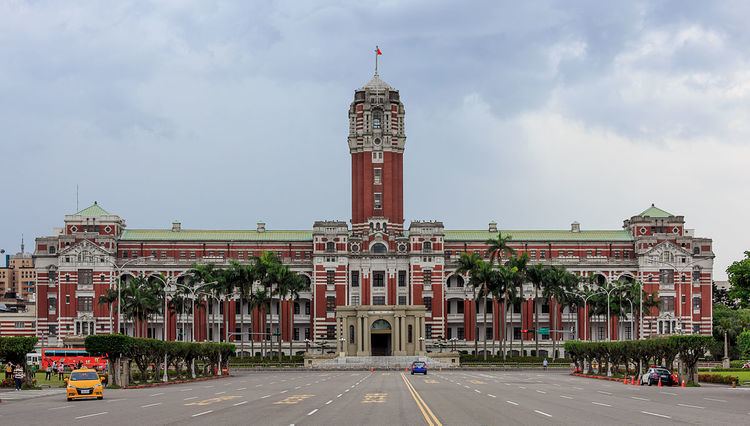Alternative names Presidential Palace Location Taipei, Taiwan Opened March 1919 | Architectural style Renaissance-baroque Elevation 8m Phone +886 2 2311 3731 | |
 | ||
Former names Governor-General's Office Current tenants ROC President
ROC Vice President Address No. 122, Section 1, Chongqing South Road, Zhongzheng District, Taipei City, Taiwan 100 Hours Closed now Sunday9AM–5PMMonday9AM–5PMTuesday9AM–5PMWednesday9AM–5PMThursday9AM–5PMFriday9AM–5PMSaturday9AM–5PMSuggest an edit Architects Matsunosuke Moriyama, Uheiji Nagano Similar Chiang Kai‑shek Memorial, National Palace Museum, Ximending, Taipei 101, Taipei Guest House Profiles | ||
The Presidential Office Building houses the Office of the President of the Republic of China. The building, located in the Zhongzheng District in the national capital of Taipei, Taiwan, was designed by architect Uheiji Nagano during the period of Japanese rule of Taiwan (1895–1945). The structure originally housed the Office of the Governor-General of Taiwan. Damaged in Allied bombing during World War II, the building was restored after the war by Chen Yi, the Governor-General of Taiwan Province. It became the Presidential Office in 1950 after the Republic of China lost control of mainland China and relocated the nation's capital to Taipei at the end of the Chinese Civil War. At present, this Baroque-style building is a symbol of the ROC Government and a famous historical landmark in downtown Taipei.
Contents
- Fuel cell scooter around taiwan drove pass the president office building in taipei mpg
- Design
- History
- Chronology
- Transportation
- References
Fuel cell scooter around taiwan drove pass the president office building in taipei mpg
Design
The Presidential Office Building occupies the city block between Chongqing South Road and Bo'ai Road in downtown Taipei. It is designed in the shape of two squares stretching from Baoqing Road to Guiyang Street.
The 130 meter-wide facade faces east down multi-lane Ketagalan Boulevard. This reflects the concerns of its Japanese architects, who often oriented important structures toward the rising sun at the head of long avenues. (This feature may also be seen in Main Library of National Taiwan University.)
The building has ten entrances but only the front entrance and west gate are used for official functions. In the original design an ornate Baroque-style domed entrance hall greeted visiting dignitaries. This entrance hall was reconstructed with simpler interior features after destruction of the first hall in World War 2. The west gate, the formal rear entrance of the building, features a grand marble staircase and porch lined with Ionic and Corinthian pillars.
The two-part main building, six stories high, mainly houses government offices and maintenance services. The office wings feature balconies and long corridor that allow view of the sunlit North and South Gardens.
The 60-meter tower at the center of the building was the tallest structure in the Taipei Basin during Japanese rule. When the Nationalist regime took power, a platform was built at the top floor to enable martial flag-raising ceremonies.
The Presidential Office Building stands within walking distance of 228 Memorial Park, the National Taiwan Museum, the original hospital of the National Taiwan University, the original East Gate of the City of Taipei, the Chang Yung Fa Foundation Building (formerly Kuomintang Party Headquarters) and the National Theater and Concert Hall at Chiang Kai-shek Memorial Hall. A few blocks to the west is Taipei's popular Ximending shopping district with its historic cinema and Jhongshan Concert Hall. A few blocks to the north is Taipei Main Station and Shin Kong Life Tower.
History
At the time Japanese rule of Taiwan and the Pescadores began in 1895, the Governor-General of Taiwan set up temporary headquarters at the former Qing Dynasty secretariat. The new rulers began making long-term plans for development of the island. The plans soon included building a new headquarters for the Governor-General. A two-stage architectural design contest was held in 1906 and 1910.
The architectural design of Uheiji Nagano was selected in 1910. Aspects of the design typical of Japanese architects in Taiwan's colonial period include a facade facing east and a creative blend of traditional European elements (Renaissance, Baroque and neo-Classical). Plans were submitted to Tokyo where revisions were made to Nagano's original design. Tokyo authorities increased the height of the initial six-story central tower to 11 stories and made defensive improvements to the defense and corner towers. Construction began in June 1912 and was completed in March 1919 at a cost of 2.8 million Japanese yen. Undoubtedly, it became one of the best-known masterpieces during the period of Japanese rule of Taiwan after the construction finished.
During the Second World War, the building suffered heavy bombing from the Allied Powers and was severely damaged. On 31 May 1945, during the Raid on Taihoku, bombs hit the front left side, main lobby, and northern sections of the Taiwan Governor-General's Office. The fire burned for three days, damaging large parts of the building. Forty-five days after the air raid, Japan surrendered.
The building was not repaired until 1947, when the Taiwan Provincial Government initiated a restoration plan funded through private donations. The restoration involved approximately 81,000 workers and was completed at the end of 1948, looking only slightly different from the original building. Since the timing of the restoration's completion coincided with the 60th birthday of President Chiang Kai-shek, it was renamed Chieh Shou Hall. ("Chieh Shou" means "Long live Chiang Kai-shek".) Beginning in mid-1949, the building served as the southeast military affairs office and, following the retreat of the ROC central government from mainland China to Taiwan, it became the Office of the President in 1950. Since 2006 the name Chieh Shou Hall was dropped. The structure is officially referred to in English simply as the Presidential Office Building.
Chronology
Transportation
The building is accessible within walking distance South West from NTU Hospital Station of the Taipei Metro.
